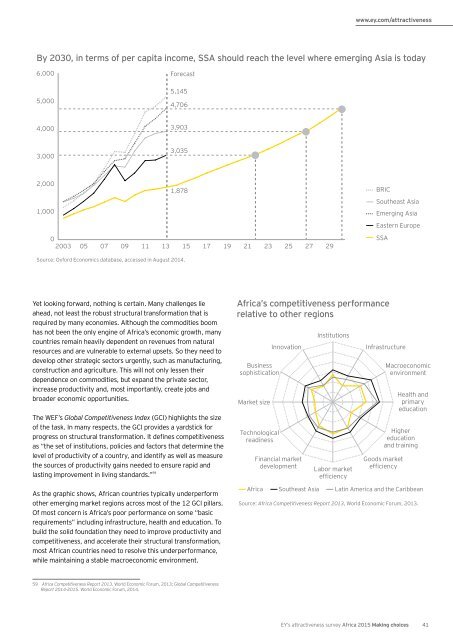Future Assuring Africa’s long-term growthSo there is good reason to celebrate the progress of a region thatonly 15 years ago was dismissed by The Economist magazineas “the hopeless continent.” That said, it is important to seeAfrica’s progress in context. Given the continent’s history ofunderdevelopment and persistent structural inequalities in theglobal economy, there is still a long way to go before Africaemerges as an economic powerhouse. In many respects, Africais today at a point where many East Asian economies were in the1970s, and where India, Mexico and Turkey were in the 1980s.In other words, Africa has made significant progress (from arelatively low base) over the last 15 years, but there is still along way to go before we can consider a critical mass of Africaneconomies to be included among the leading emerging markets.Africa’s continued rapid growth is not inevitable, and will notsimply take care of itself. At the very least, the unsettling resultsof our perception <strong>survey</strong> this year remind us that we should nottake belief in Africa’s rise for granted.Addressing the challenge of structural transformationThe apparent softening of investor confidence echoes a shiftin mood that we noted last year at the Strategic Growth ForumAfrica — an annual event hosted by <strong>EY</strong>. The tone of previousevents in recent years had been more celebratory. While thechallenges of doing business in Africa were acknowledged andanalyzed, there was previously a distinct sense of optimism bornof the clear progress that Africa had made over several years.At our most recent event, while the sense of optimism was stillstrong, it was tempered by the reality of how much still needs tobe achieved to realize a future in which, as Graça Machel, NelsonMandela’s widow and founder of New Faces, New Voices (NFNV),put it, “we build an inclusive Africa, while leaving nobody behind.”Although Africa’s economic growth has been impressive over thepast 15 years, poverty and inequality remain intractable realities.With the fastest-growing population in the world, we face a verytough challenge to create the jobs and economic opportunitiesthat will lift ever greater numbers of Africans out of poverty.SSA is lagging other developing regions, where populations aregrowing more slowly, in raising levels of GDP per capita — a broadindicator of rising income levels and better living standards.GDP per capita growthLiving standards in SSA have not yet accelerated in the sameway as in some other emerging market regions.GDP purchasing power parity percapita, US$ at current prices15,00012,0009,0006,0003,000019901992199419961998SSA Developing Asia Latin America and the CaribbeanSource: IMF; Africa Competitiveness Report <strong>2015</strong>, World Economic Forum, <strong>2015</strong>.We should not overstate the implications of the widening gap inGDP per capita, particularly between developing Asia and SSA.Growth in developing Asian economies started in the early 1980s,and in a global economic context that was more conducive to theexport-driven growth that has characterized Asia’s rise. It wasanother 15 years before GDP per capita in Asia began to risesubstantially, in the mid-1990s. Assuming a similar lag in SSA, wecould expect that GDP per capita levels will begin rising markedlyover the next 10–15 years.200020022004200620082010201240 <strong>EY</strong>’s <strong>attractiveness</strong> <strong>survey</strong> Africa <strong>2015</strong> Making choices
www.ey.com/<strong>attractiveness</strong>By 2030, in terms of per capita income, SSA should reach the level where emerging Asia is today6,0005,000Forecast5,1454,7064,0003,9033,0003,0352,0001,878 BRICSoutheast Asia1,000Emerging AsiaEastern Europe0SSA2003 05 07 09 11 13 15 17 19 21 23 25 27 29Source: Oxford Economics database, accessed in August 2014.Yet looking forward, nothing is certain. Many challenges lieahead, not least the robust structural transformation that isrequired by many economies. Although the commodities boomhas not been the only engine of Africa’s economic growth, manycountries remain heavily dependent on revenues from naturalresources and are vulnerable to external upsets. So they need todevelop other strategic sectors urgently, such as manufacturing,construction and agriculture. This will not only lessen theirdependence on commodities, but expand the private sector,increase productivity and, most importantly, create jobs andbroader economic opportunities.The WEF’s Global Competitiveness Index (GCI) highlights the sizeof the task. In many respects, the GCI provides a yardstick forprogress on structural transformation. It defines competitivenessas “the set of institutions, policies and factors that determine thelevel of productivity of a country, and identify as well as measurethe sources of productivity gains needed to ensure rapid andlasting improvement in living standards.” 59As the graphic shows, African countries typically underperformother emerging market regions across most of the 12 GCI pillars.Of most concern is Africa’s poor performance on some “basicrequirements” including infrastructure, health and education. Tobuild the solid foundation they need to improve productivity andcompetitiveness, and accelerate their structural transformation,most African countries need to resolve this underperformance,while maintaining a stable macroeconomic environment.Africa’s competitiveness performancerelative to other regionsBusinesssophisticationMarket sizeTechnologicalreadinessFinancial marketdevelopmentAfricaInnovationSoutheast AsiaInstitutionsLabor marketefficiencyInfrastructureMacroeconomicenvironmentHealth andprimaryeducationHighereducationand trainingGoods marketefficiencyLatin America and the CaribbeanSource: Africa Competitiveness Report 2013, World Economic Forum, 2013.59 Africa Competitiveness Report 2013, World Economic Forum, 2013; Global CompetitivenessReport 2014–<strong>2015</strong>. World Economic Forum, 2014.<strong>EY</strong>’s <strong>attractiveness</strong> <strong>survey</strong> Africa <strong>2015</strong> Making choices41



